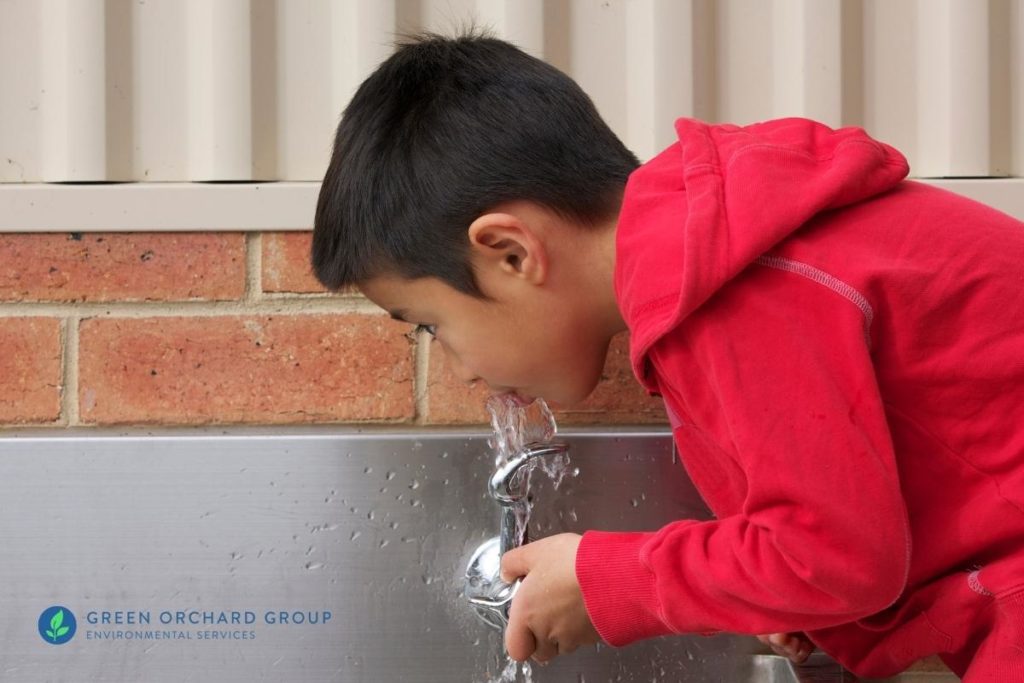
Although efforts have been made over the last two decades to identify and remove sources of lead, it continues to be present today in school drinking water.
Lead Contamination in School Water
Lead is a dangerous toxin that can cause problems with behavior and cognitive development in young children, even at very low levels of exposure. It’s especially problematic in schools, where children spend most of their time outside of home.
An audit by New York City’s Comptroller’s office found that, between 2016 and 2019, 84% of city schools had at least one water fixture with elevated lead.
In 2016, New York became the first state to require testing and remediation of drinking water in public schools (Subpart 67-4 Lead Testing in School Drinking Water). This required schools to have all drinking water outlets to be sampled and tested for lead once in 2016, once in 2020, and once every 5 years thereafter.
The New York State legislature passed an updated set of requirements in December of 2021 to further improve New York’s programs to protect children from lead exposure. This reduced the action level for lead concentrations in drinking water from 15 ppb (parts per billion) to 5 ppb and changed the required testing frequency from every 5 years to every 3 years.
10 NYCRR Subpart 67-4: Lead Testing in School Drinking Water
10 NYCRR Subpart 67-4: Lead Testing in School Drinking Water went into effect in 2016 and requires schools to test drinking water for lead contamination. Corrective action must be taken if the amount of lead detected exceeds the action level threshold.
The lead testing requirements laid out in Subpart 67-4 (updated for 2022) include:
- Monitoring and Sampling
- Response and Corrective Action
- Reporting and Recordkeeping
These regulations applies to all New York State public school districts and Boards of Cooperative Educational Services (BOCES), as well as any buildings owned or leased by public schools.
They does not apply to private schools, charter schools, Indian Nation schools, or daycare facilities (which have their own requirements to test for lead contamination in water).
Monitoring and Sampling Requirements
- Schools must test potable water outlets for lead contamination by collecting “first-draw” samples — water samples collected from a cold water outlet before any water is used. Water must be motionless in the pipes for 8 to 18 hours before sample collection.
- The deadline for the first round of lead water tests was in 2016.
- The deadline for the second round of lead water tests was in 2020.
- Subsequent rounds of lead water tests must be performed every 3 years (per the newest bill passed in December 2021: S. 2122-A/A. 160-B).
Sampling may be performed by an individual familiar with lead testing regulations and a “first-draw” sampling protocol, such as a school staff member, a laboratory representative, or a third-party consultant (lead inspector).
After samples are taken, they must be analyzed by a laboratory that is certified by the Environmental Laboratory Approval Program (ELAP) to perform lead testing for drinking water.
Response and Corrective Action
The current action level for lead in school drinking water is 5 ppb (lowered from 15 ppb, per S. 2122-A/A. 160-B). Lead water test results that exceed the action level of 5 ppb requires the outlet to be taken out of service, in addition to further testing and remediation.
- Prohibit the use of the outlet immediately.
- Provide building occupants with an adequate supply of drinking water until remediation is performed.
- Report the laboratory test results to the local health department within 1 business day.
- Notify all staff and parents of students in writing within 10 business days.
- Post numeric test results and information about remediation actions taken on the school’s website within 6 weeks.
Appropriate corrective actions and remediation options include permanently removing the outlet, replacing the outlet or pipe(s) with “lead-free” plumbing materials, implementing a systemic flushing program, and using Point-of-Use (POU) filters.
Other examples of corrective actions include adding signage, supervision, engineering controls, and education.
Reporting and Recordkeeping
Schools can report lead water testing summary data electronically to New York State’s Health Electronic Response Data System (HERDS), which is accessed through the Health Commerce System (HCS).
The report must be filed within 10 business days of receiving the laboratory reports. It should include:
- General information about the school
- Sampling information
- Lead analysis results
- Response and remediation
Schools are required to retain lead testing reports and remedial action plans for 10 years following document creation.
Best Practices to Reduce Lead in Drinking Water
Here are a list of best management practices to help reduce the amount of lead in school drinking water, according to the New York State Department of Health:
- Aerator cleaning
- Routine flushing practices
- Only use certified lead-free materials when performing plumbing work
- Follow manufacturers’ recommendations for water softener settings
- Temperature control
- Point-of-Use (POU) filter maintenance
- Educating staff and students to run water at a tap for 30-60 seconds — or until the water feels cold — prior to drinking or using it for food preparation.
Need Help with Lead Testing at Your School or Childcare Facility?
Green Orchard Group is a leading environmental health & safety services company in New York City. We are a team of experienced and EPA-certified lead inspectors and remediation professionals, providing reliable water testing and lead remediation services to a large number of schools in the New York Tri-State area.
If you need lead testing at your school or childcare facility, or for another type of residential or commercial property, call or contact Green Orchard Group today!
